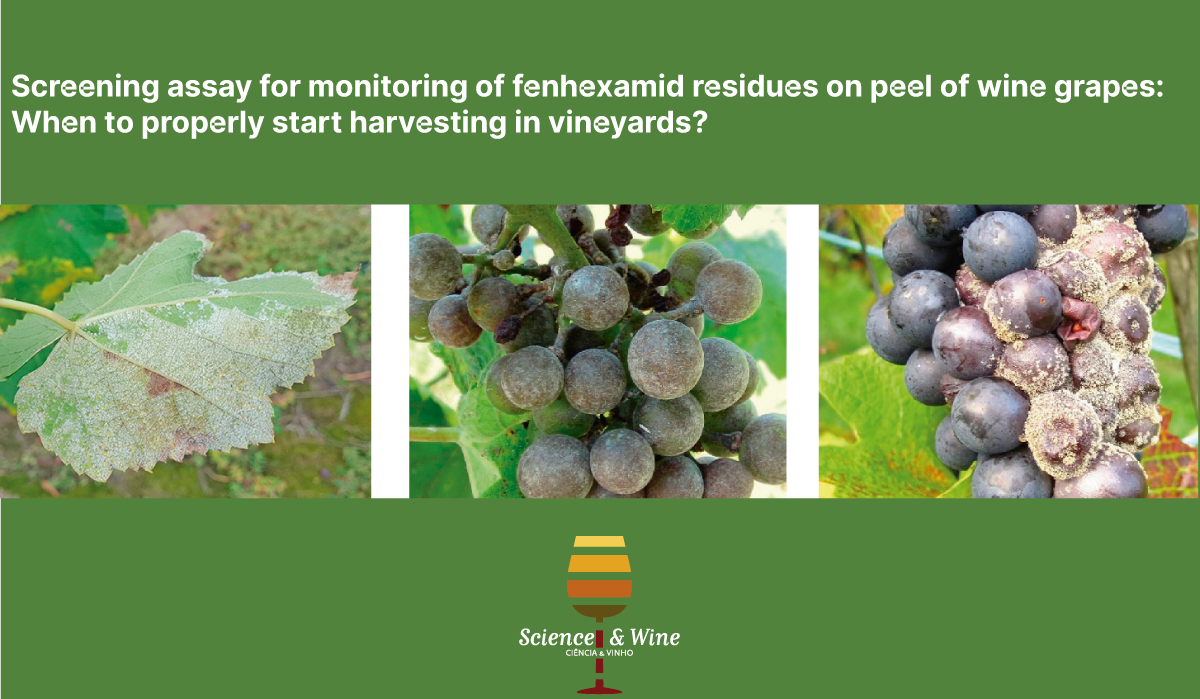By Milan Sýs and Mariola Brycht
These findings are described in the article:
Brycht, Mariola; Łukawska, Anna; Frühbauerová, Michaela; Pravcová, Kateřina; Metelka, Radovan; Skrzypek, Sławomira; Sýs, Milan (2021) Rapid monitoring of fungicide fenhexamid residues in selected berries and wine grapes by square-wave voltammetry at carbon-based electrodes. Food Chemistry 338 (127975) 1-7. https://doi.org/10.1016/j.foodchem.2020.127975
Wine represents an alcoholic drink typically made from fermented juice of wine grape (Vitis vinifera). From currently more than 5,000 varieties, only a few of them are of commercial significance for wine production. However, growing vines cannot do without the necessary protection against fungal diseases. The most serious and widespread vine disease is Plasmopara viticola, which is also sometimes called “Downy mildew”. At first, yellow-green watery spots appear on the leaves and a whitish coating of spores appears on the underside. Infested berries turn brown and dry. The disease spreads mainly in humid, rainy and warm weather. The most important measure against this disease is to perform 2-3 treatments in the period after flowering at intervals of about 14 days. Protection against this fungal disease is carried out by spraying with fungicides.
In the last decade, “Powdery mildew”(Uncinula necator) can be considered as another important fungal disease that causes more damage than above-mentioned “Downy mildew”. It usually attacks all the green parts of vine bush, where a white-gray floury coating forms on the infested areas. Visible cracks on the attacked wine grapes are typical symptom of this serious fungal disease. As in the previous case, ideal natural conditions for the spread of mildew are warm weather and alternating humidity. Where Uncinula necator occurs, whole vine bushes have to be regularly treated two times before flowering, first in the 5-6 leaf phase. Furthermore, the spraying of fungicides is carried out against Uncinula necator at the same time as for Plasmopara viticola.
The third serious fungal disease is gray mold (Botrytis cinerea). The most visible symptoms are on ripening and ripe wine grapes, where putrid spots appear, the skin peels off and cracks. In wet weather, gray spore coatings appear on the affected parts. It is important for wine growers to avoid attacking the ripening wine grapes by spraying during the so-called grape locking (first half of August). For demonstration, manifestations of the three most common fungal diseases are shown below in Figure 1.

To protect the wine grapes against fungal diseases, numerous fungicide preparations are commercially available. Fungicides can be divided onto three main groups, namely contact fungicides which protect plant tissue topically, translaminar fungicides are redistributed from the upper sprayed leaf surface to the lower unsprayed surface, and systemic fungicides enter into plant tissue and are distributed by xylem vessels throughout the plant. Nowadays, the tendency to replace hazardous fungicides by extracting oils from seaweed, horsetail, fennel or orange peel is gaining attention. However, synthetic fungicides represents the most commonly-used vine protectives due to low acquisition costs.
Generally, washing the wine grapes with tap water is ineffective to remove contact fungicides from the peels, as the amount of removed fungicides was only 43%, and just up to 60% is removed using commercially available detergents. The desired destruction and removal efficiency can be achieved using organic solvents [1].
Most fungicides leave detectable residues on wine grapes and, for safety reasons, have a restriction on when the last spray can be applied prior to harvest. Moreover, yeasts (Saccharomyces cerevisiae), known as basically single-celled fungi, can be killed or inhibited by fungicide residues, leading to so-called “stuck” fermentations. To know the time when to properly start harvesting in vineyards could be determined by a rinsed screening voltammetric method developed as an electrochemical assay for monitoring the content of fungicide fenhexamid (FNX) on peel of wine grapes [2]. In principle, wine grapes are rinsed with pure MeOH using ultrasonic bath for certain time. After filtration through a folded filter paper, the total volume is reduced at 70 °C (boiling points of MeOH is 65 °C and FNX is 320 °C). Finally, resulting concentrate is mixed with working medium and can be analysed using square-wave voltammetry at commercially available carbon-based electrodes, as shown in Figure 2.

Monitoring of pesticides residues in foodstuffs is performed by protocol ČSN EN 15662 (560680) utilizing reversed-phase high-performance liquid chromatography (RP‑HPLC) with spectrophotometric detection, based on the European Union regulation. The electrochemical assay is fully comparable with the reference method. However, it has not been able to use for simultaneous determination with other common fungicides yet. Usually in electroanalysis, one analytical method was developed for one fungicide [3]. If wine growers applies the TELDOR® 500 SC on wine grapes to protect against gray mold, the present electroanalytical assay will be available to use for FNX monitoring to know when to start the harvesting in vineyards.

Milan Sýs 
Mariola Brycht 
Dr. Mariola Brycht is appointed as an Assistant Professor in Electroanalysis and Electrochemistry research unit at the Department of Inorganic and Analytical Chemistry, Faculty of Chemistry, University of Lodz (Lodz, Poland), where she got her PhD in 2015. Her research fields cover development and physico-chemical characterization of novel electrochemical carbon-based electrode materials, including boron doped diamond, glassy carbon, carbon paste, for sensing of biologically active organic compounds with large interest (e.g., different classes of drugs, pesticides), and miniaturization of electrochemical detection devices. She is experienced from many internships, and among all, the most important being those at Charles University (Prague, Czech Republic), Karl-Franzens University (Graz, Austria) and University of Novi Sad (Novi Sad, Serbia).
References
- Angioni A, Schirra M, Garau VL, Melis M, Tuberoso CIG, Cabras P (2004) Residues of azoxystrobin, fenhexamid and pyrimethanil in strawberry following field treatments and the effect of domestic washing. Food Additives and Contaminants 21:1065–1070. https://doi.org/10.1080/02652030400010066
- Brycht M, Łukawska A, Frühbauerová M, Pravcová K, Metelka R, Skrzypek S, Sýs M (2021) Rapid monitoring of fungicide fenhexamid residues in selected berries and wine grapes by square-wave voltammetry at carbon-based electrodes. Food Chemistry 338:127975(1–7). https://doi.org/10.1016/j.foodchem.2020.127975
- Pérez-Fernández B, Costa-García A, Escosura- Muñiz A (2020) Electrochemical (bio)sensors for pesticides detection using screen-printed electrodes. Biosensors 10:32(1–26). https://doi.org/10.3390/bios10040032

